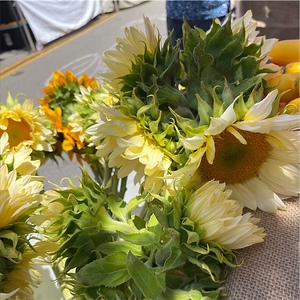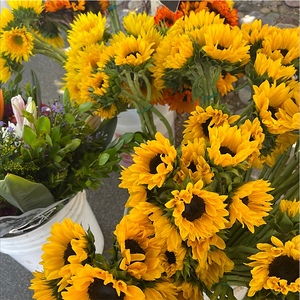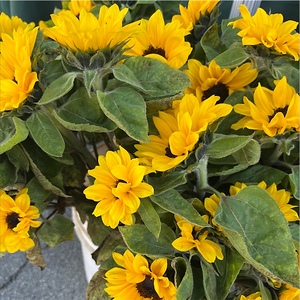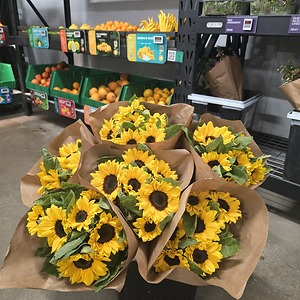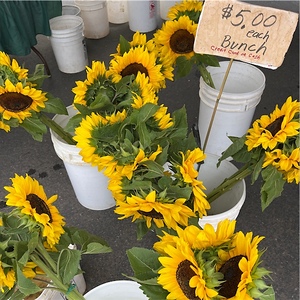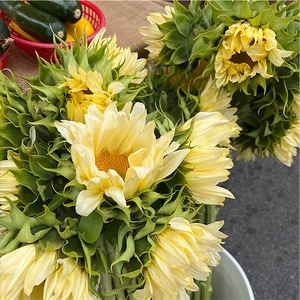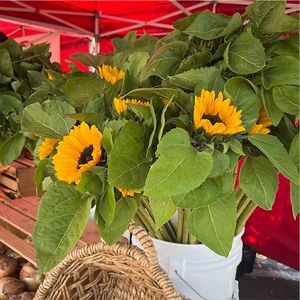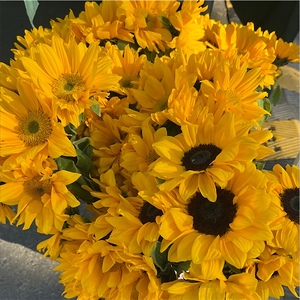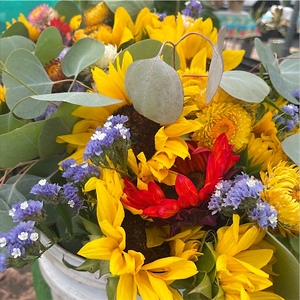


Yellow Sunflowers
Estimated Inventory, bunch : 0
This item was last sold on : 06/27/25
Description/Taste
Sunflowers are comprised of a composite flower that grows on top of slender, coarse stalks with large and broad, green leaves. The flower heads range in size from small to large, with some varieties spanning 25 to 30 centimeters in diameter. Each flower contains small disc florets in the center of the head and a ring of ray florets, which are the brightly colored petal-like structures seen on the outside edge. One Sunflower can produce 1,000 to 2,000 disc florets, and these small reproductive florets begin yellow-green, eventually turning brown-black, developing the plant’s edible seeds. The disc florets also sit on top of a large heart, which is a dense, meaty portion of the flower. The ray florets are sterile and can range in color from bright yellow, maroon, red, brown, to orange. These florets can also be arranged in a single or double overlapping layer, depending on the cultivar. Sunflowers have several edible parts, including the heart, seeds, stems, leaves, and ray florets. The pigmented ray florets have a chewy texture with a vegetal, slightly bitter flavor, and the leaves and stems also contain an herbaceous, green taste. Sunflower seeds have a sweet and nutty flavor. The buds, once cooked, resemble an artichoke in both texture and flavor, and the cooked hearts contain a sweet corn flavor mixed with an earthy bitterness.
Seasons/Availability
Sunflowers are available in the summer through early fall.
Current Facts
Sunflowers, botanically classified as Helianthus annuus, are brightly colored annuals belonging to the Asteraceae family. There are many different full-sized and dwarf varieties of Sunflowers that have been bred over time, with some cultivars reaching only 38 centimeters in height while others tower over 5 meters. Sunflowers are native to the Americas, and their scientific name is derived from the Greek words “helios,” meaning “sun” and “anthos,” meaning “flower.” The flowers received this name for their brightly colored appearance and heliotropic nature, a unique trait that allows the flowers to physically follow the sun to increase light exposure for photosynthesis. The flowers typically move from east to west, mirroring the sun's path, and repeat this process daily. Sunflowers are deeply rooted in the cultural and culinary practices of civilizations worldwide. In culinary preparations, the stalks, petals, buds, hearts, seeds, and leaves are all edible and can be incorporated into both raw and cooked applications.
Nutritional Value
Sunflowers have several edible components with various nutritional properties. The seeds are an excellent source of potassium to balance fluid levels within the body, vitamin E to protect the cells against free radical damage, and iron to develop the protein hemoglobin for oxygen transport through the bloodstream. The seeds are also a good source of phosphorus, folate, magnesium, zinc, and vitamin C. Beyond the seeds, Sunflower petals contain carotenoids, including xanthophyll, a pigment that gives the petal its yellow hue, which provides antioxidant-like properties to the body to strengthen the immune system and reduce inflammation. In natural medicines, Sunflowers were used by Native Americans to treat insect and snake bites. The flowers were mashed and spread over the skin, or the juice of cut stems was topically applied and allowed to dry, creating a barrier to protect sensitive skin areas.
Applications
Sunflowers have many different edible parts that bear vegetal, herbaceous, and nutty flavors well suited for a variety of fresh and cooked preparations. The young, unopened buds can be steamed whole, served with lemon juice, and have an earthy flavor similar to artichokes. Larger versions of the buds, known as the Sunflower heart or head, can also be braised or grilled, bearing a sweet, corn-like taste with a subtle earthy bitterness. In addition to the buds and heart, Sunflower ray florets, the brightly colored petal-like structures, are popularly used as an edible garnish and can be sprinkled over salads, soups, grain bowls, and roasted meats. It is important to note that the ray florets contain a bitter flavor and require a sweet or fatty element to create a balanced dish. The petals can be served with rich cheeses and meats in savory applications, as a jelly, jam, cake, or cookie garnish in desserts, or combined with naturally oily seeds in recipes for bread, muffins, and pesto. Sunflower leaves and stems can be cleaned, trimmed, and utilized as a dipping vessel on appetizer plates, or they can be stir-fried, steamed, or combined into vegetable dishes. Beyond the more unique elements of Sunflowers, the seeds are also edible and can be consumed straight, out of hand, toasted for a savory, warm flavor, or mixed into salads, appetizer bowls, or nut blends. Sunflowers pair well with herbs such as thyme, parsley, bay leaves, and basil, sundried tomatoes, garlic, olive oil, lemon juice, ricotta cheese, and parmesan cheese. Whole Sunflower heads should be immediately consumed once harvested for the best quality and flavor. The ray florets can also be stored for a couple of days in a sealed container in the refrigerator.
Ethnic/Cultural Info
Sunflowers were used in medicinal, cultural, spiritual, and culinary practices throughout the Native American tribes in North America. Wild versions of Sunflowers were traditionally bushy plants with several flower heads, but over time, indigenous peoples cultivated the plants to exhibit larger, single-headed flowers with a higher seed count. Sunflowers were one of the only crops to be domesticated in North America, and some experts consider the flowers to be the “fourth sister” in the ancient three-sister planting system of growing squash, beans, and corn. The seeds were traditionally consumed raw, pounded and rolled into a type of nut butter energy ball, or toasted and ground into flour for bread. Sunflowers were also used to develop purple and yellow dye for clothing, textiles, decorating baskets, and painting the skin for ceremonies. Among the Hopi, a Native American tribe in the Southwestern United States, Sunflowers were protected by the goddess Kuwanlelenta, her name meaning “to make beautiful surroundings.” Sunflowers represented femininity, fertility, and beauty, and the Hopi believed each Sunflower represented a living soul.
Geography/History
Sunflowers are native to North America and have been growing wild since ancient times. The flowers were believed to have been cultivated by Native Americas in the Southwestern United States since 3000 BCE and were selectively bred each season to become a singular flower on one stalk. There were also a few species discovered in the Andes Mountains in South America. In the 16th century, Spanish explorers encountered Sunflowers in the New World and brought the seeds back with them to Europe, where the flowers became extensively cultivated throughout Western Europe and Russia. Later in the 19th century, approximately two million acres of Sunflowers were being grown in Russia, mainly utilized for oil production. Russian Sunflower varieties were introduced to the United States in the late 19th century, and many of the commercial varieties cultivated in modern-day markets are derived from these cultivars. Today Sunflowers are grown worldwide in semi-arid climates and are cultivated for their flowers, seeds, and oil. Fresh flowers for culinary use can be found through farmer’s markets and specialty distributors. They are also frequently grown in home gardens.
Featured Restaurants
Restaurants currently purchasing this product as an ingredient for their menu.
| Le Coq | La Jolla CA | 858-427-1500 |
Recipe Ideas
Recipes that include Yellow Sunflowers. One
| The Nerdy Farm Wife |
|
Sunflower Jelly |
| Absolute Ambrosia |
|
Sunflower Pesto |
| Curiosita Ellya |
|
Carrot Sun Flowers Sandwich Cookies |
| Forager Chef |
|
Sunflower Artichokes |



